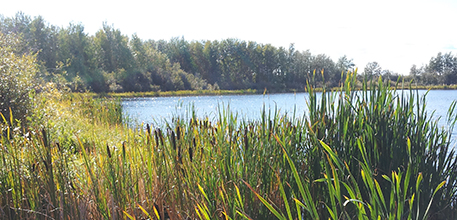| | Landscape
Land Cover
Many variables can reflect changes in land cover. This section looks at the status of wetland and riparian areas.
Wetland Area
Wetlands provide many cultural and ecological benefits. They supply food and recreational opportunities, and fulfill spiritual and inspirational needs. They store water, mitigate floods and droughts, moderate water flow, stabilize shorelines, and discharge and recharge groundwater. Moreover, wetlands play a critical role in water purification, especially those that contain herbaceous plant species such as cattails (Typha latifolia), sedges (Carex spp.) and bulrushes (Schoenoplectus spp.).
Wetlands also moderate weather and climate, and process and store greenhouse gases. The accumulation of carbon in bog and fen sediments is of global importance. Wetlands' high biological productivity and aquatic components provide diverse wildlife habitats. In northern Alberta, wetlands provide key rearing and overwintering habitat for fish and are primary habitats for birds, amphibians, beavers, mink, muskrats, otters and plants. Wetlands provide important supplementary habitat for moose, caribou, and songbirds.
Measuring wetlands repeatedly over time can identify changes to local hydrological patterns and water quality. Unfortunately, few measurements exist in the Mighty Peace watershed that could indicate how much wetland area has been converted from its natural state. The baseline information in this report should serve as a monitoring tool for the future.
Wetlands
Wetlands cover nearly 30% (52,898 km2) of the watershed (outside of national parks, for which information was unavailable). Shallow open-water areas are also not covered, because the satellite cameras used cannot differentiate between lakes and other open-water areas. The map at right shows the distribution of wetlands across the watershed. The mountain and foothills regions have few wetlands because they are steep enough that surface water tends to drain off. The less well-drained flatlands have more wetlands. The extent of wetland area is a reflection of the natural land cover and land use. The regions with high coverage of wetlands correspond with extensive boreal forest areas and little human activity.
|
|

 Hover to magnify map

Source: ESRD9
| ? | INFO GAP |
| Wetland data for Wood Buffalo Park
|
|
|
